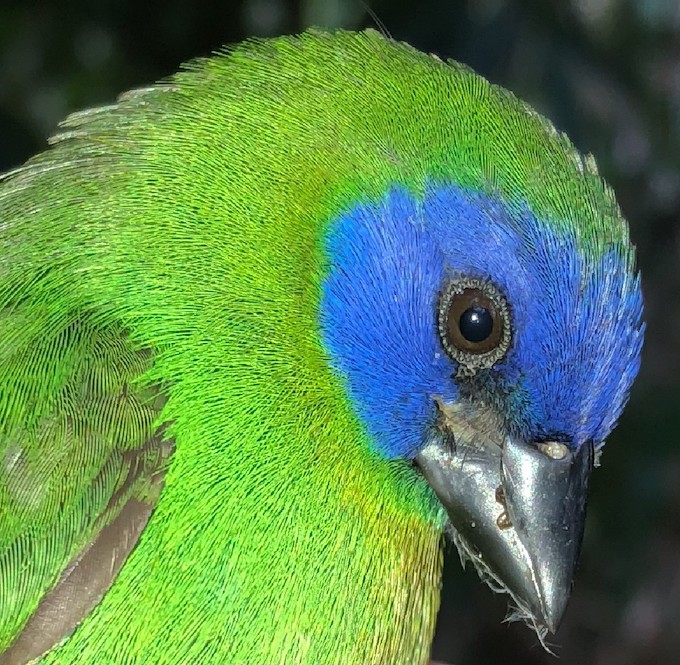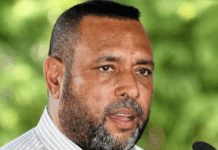
By Priestley Habru in Honiara
Solomon Islands’ environmental authorities have highlighted the need to protect the forests from logging following a recent report on new distributional sightings of the blue-faced parrotfinch, or Erythrura trichroa.
The bird revealed its existence on Malaita and Makira islands and the report, published in the Wilson Journal of Ornithology on 4 August 2020, was based on fieldwork done between 2015 and 2018 by a team from the Department of Biology at the University of New Mexico in the United States.
The report expands the known distribution of the species beyond Kolombangara and Guadalcanal, two of the Solomon Islands where it had previously been recorded, and signals the need to protect the country’s rainforests from the threats of commercial logging.
Jenna McCullough, one of the scientists involved in the study, said she hoped this information could contribute to an increased understanding of the evolutionary history and diversity of avian life on the Solomon Island archipelago.
Lead author Lucas DeCicco said he hoped the report would provide information that local communities could use to bolster efforts to conserve land for future generations.
“Many areas of the Solomon Islands are under threat from mining and forestry development, including areas on Malaita and Makira where we found blue-faced parrotfinches,” said DeCicco from the University of Kansas.
However, logging operations has been allowed by the very landowners who had allowed the scientists to study the bird on their land in Malaita Province.
When people do not see a large enough payout from conservation, they are willing to switch to something that is more economically lucrative, hence the support for mining, researchers say.
“Now they have switched to logging,” noted one of the report’s local co-authors, Dr Edgar Pollard.
There is currently a logging operation in Hahorarumu Uru conservation area on Malaita where the parrotfinch was sighted and studied in 2015 that puts its population at risk.
Providing validation
Dr Pollard said such scientific research verified and supported the need to protect these areas by showing there were still new species and important findings to be discovered.
It is very difficult to secure support for conservation work if there is no scientific evidence of the existence of biodiversity or different species, he said.
“So, we encourage our young people to engage in scientific studies, and a strength of this particular study was the collaboration of local and international scientists, which I believe is critical,” Dr Pollard added.
“Hopefully in the future we will be able to see more local scientists leading such studies.”
Dr Pollard founded the Mai-Maasina Green Belt (MMGB), which is focused on establishing the necessary infrastructure and supporting research and training activities to encourage rural communities to adopt a green approach to development.
“I want to also note that though these findings may be new to the world of science, they are not new to the local peoples that have stewardship over these species,” he said.
The vital role of birds
Birds are important for the environment as they are the key dispersers of seeds and pollinators for plants.
“Therefore, in a country with high deforestation we must look after our birds who play an important role in helping our forests recover,” said Dr Pollard.
Josef Hurutarau, deputy director of conservation at the Ministry of Environment, Climate Change, Disaster Management and Meteorology (MECDM), said the report provided useful information given the need to understand the conservation status of the Solomon Islands’ flora and fauna.
“In conservation programs at the national level, it is our aim to know exactly the distribution and population of species, especially those that are endemic, threatened and near extinction in the Solomon Islands,” Hurutarau said.
Given limited resources and capacity within the government, Hurutarau said the ministry was working to improve its database of such endemic birds and set baselines to help direct its efforts and priorities.
In the case of Malaita and Makira, the MECDM now considers them among the country’s key biodiversity areas (KBAs), and Hurutarau said the ministry wanted to ensure effective conservation programmes were initiated.
The MECDM is also anticipating donor funding will become available to put toward a project for targeted areas, such as terrestrial-integrated forests, to be declared under the Protected Areas Act 2010.
“This would really help maintain key habitats and forest areas for these species and protect them from threats from logging and subsistence farming,” said Hurutarau.
“We will continue to encourage the efforts of researchers who can contribute to understanding our flora and fauna,” he added.
A need for new research
The first resident commissioner of the British Solomon Islands Protectorate, C.M. Woodford, first found and collected the blue-faced parrotfinch on Guadalcanal Island in 1887. Then, in 1969, the species was found on other islands within the geographic Solomon Islands – first on Bougainville in 1969 and then on Kolombangara in 1974.
Despite this rich history of exploration focused on the archipelago’s birds, the authors of the recent report said knowledge of the avifauna native to the Solomon Islands was poor.
The scientists engaged in the study were from the University of Kansas, the University of Hawai’i at Manoa, Honolulu, and the University of New Mexico. They partnered with Ecological Solutions Solomon Islands and local guides from Na’ara village on Makira and Waisisi on Malaita.
Biological surveys were conducted on Malaita in 2015 and Makira in 2018.
McCullough said the results of the study suggest there are limited genetic differences between the different parrotfinch populations across the Solomon Islands.
“Other studies have shown that there is genetic differentiation across island populations in many bird species, so this is notable for the lack of genetic differences.”
Much of the research McCullough’s larger lab group has been doing is to compare patterns of genetic similarity or differences of island birds across the Solomon Islands and greater Melanesia.
DeCicco said the report also presents the first information regarding the molecular relationships among the Solomon Island population of this species.
“Our discovery of two new populations of Blue-faced Parrotfinches highlights the need for continued biodiversity work in the region for both conservation and research,” DeCicco noted.
Priestley Habru is a Solomon Islands environmental journalist and contributor to Earth Journalism Network. This article is republished under a Creative Commons licence.











































